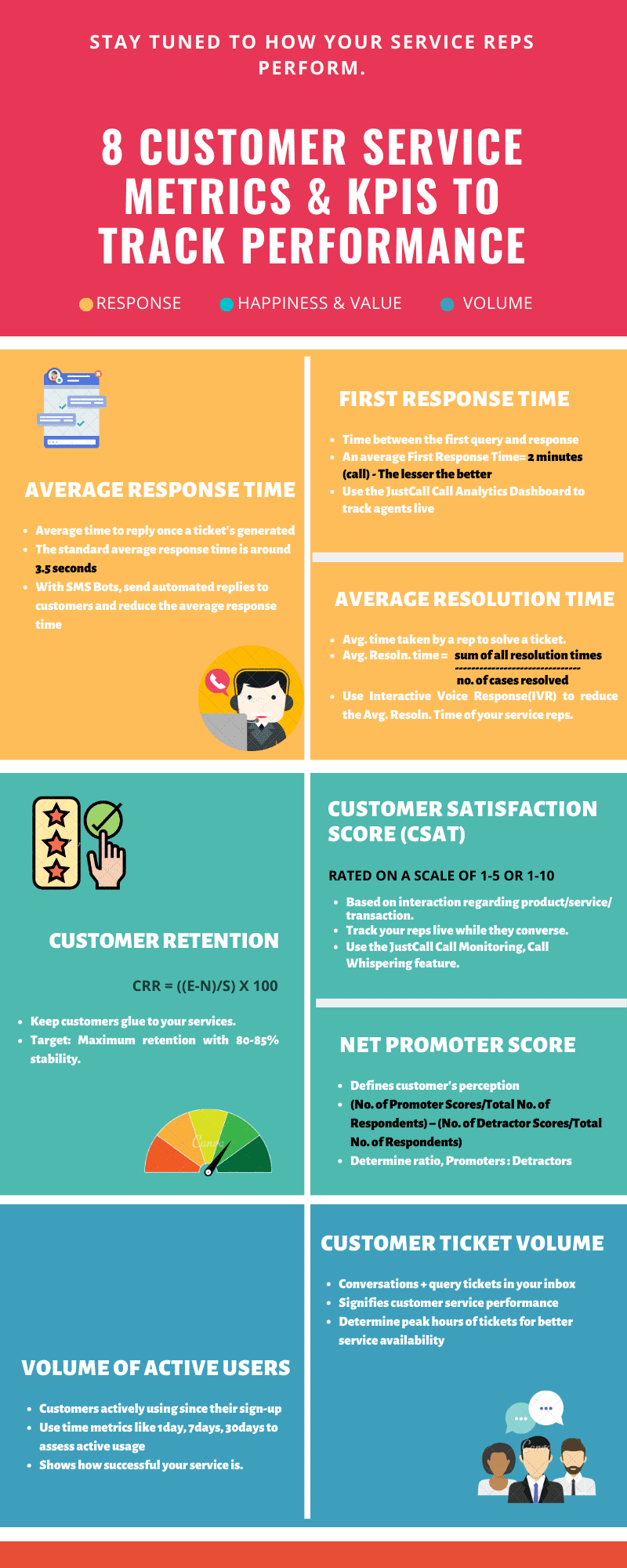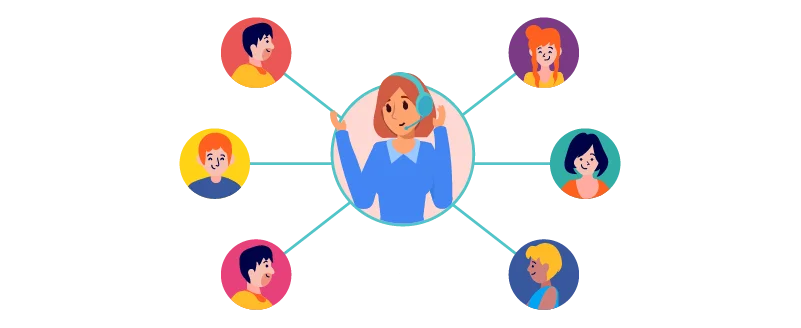To achieve maximum customer satisfaction, you must provide exceptional service. For that, you need to equip your service team to deliver high-quality assistance to your customers. This can be done by tracking customer service metrics that are most crucial to your business goals.
By doing so, you can identify pain points and eliminate them to improve customer experience and boost the efficiency of your sales reps.
So, are you confident about the customer service metrics that you are tracking? Or are you still in the trial-and-error phase?
If you are struggling with identifying the right set of customer service KPI metrics for your business, we are here to help!


What are Customer Service KPI Metrics?
The prime goal of any business, product or service is to attain maximum customer success. Though customer support thrives more on human connections, delivering seamless customer service is possible only when you live up to your customer’s expectations. And how are you going to judge that? Hence, KPIs come into play.
KPIs or Key Performance Indicators are quantifiable measures of a company’s performance over a specific time for a specific objective. Tracking these can help customer service teams to determine targets, identify low-performing areas, and gain insights to make better decisions.
They allow a company to track the success of their operations in relation to achieving customer service goals or objectives. These are like the check guides that help managers evaluate how their service employees are doing, the value that they bring to a team and the cracks that can be filled to attain maximum customer success in the long run.
KPIs are not merely numbers. They are specific factors that give you a clear idea of what and how the contribution is being made by your service department on the overall progress to make customer success possible.
Types of Customer Service KPI Categories
For those who have newly set up a service and support team, it must be very confusing to decide which customer service measurement metrics to track from day one. But keep in mind; no matter how small your team is at first, you need to focus on the right metric categories to see positive results over time.
Decide which among the numerous customer service metrics are going to be the apt indicators of impressive customer service and bring customer satisfaction. Your team will definitely grow in due course, and then what you will urgently look for is consistent assessment and management. The key to it is the right set of performance indicators.
There are a great number of customer service metrics that can be employed to track the performance of your service reps. However, these can be clubbed together under three crucial categories. They are:
- Response
- Value and happiness
- Volume
1. Response
However much you try to maintain your product quality, queries will drive in. Also, there will be times when the number of complaints will escalate. Calculating the average number of queries received(daily/weekly/monthly) will help you understand how efficient you have been in catering to your customers’ needs.
A customer waits for the earliest response. But what matters is not only ‘how fast’ but also ‘how well.’ Prefer quality over quantity. After all, customer satisfaction is of utmost priority.

2. Happiness and Value
“Your goal is not to provide just customer service but VALUABLE customer service.
Moreover, your focus should not be on building customers but building HAPPY customers.”
How your sales reps perform defines the type of relationship you build with your customers – whether it is short-lived or life-long. Certain key customer service metrics perfectly monitor the happiness and value rolled out by your service team.
3.Volume
Service reps deal with a lot of volumes, be it in terms of incoming queries or active users or maintaining conversion rates. Therefore, you need a defined set of customer service metrics that can provide insights into performances around handling such key volumes.
Apart from these three categories, there are other customer service performance metrics involving costs, query topics, customer retention, etc.

Which Customer Service Metrics Should You Track?
Let’s discuss some of the important customer service metrics that you should track to gauge your business performance. These examples of customer service performance metrics are important to note, irrespective of what kind of business you are running!
1. First Response Time
Customers are more likely to get pleased if you find them immediate answers. The first response time is the time elapsed between the moment a customer puts the first query to you and till the moment when you actively respond. In short, how long the customer waits.
The standard First Response Time is 15 minutes. Considering call, an average First Response Time should be 2 minutes. The shorter the first response time, the better.
Be it via text messages or call; quick responses work like magic. But what makes it more productive is if you, as a manager, can track the real-time responses of your service team. Tracking real-time responses maintains the quality standards of customer service.
Using the JustCall Call Analytics Dashboard, Managers and admins can track the live performance of their service plus support reps. Monitor your service team(s)’ performance using the Service Level section of the dashboard. You can also set time filters of your choice to monitor calls made or received within specific time frames.
2. Average Response Time
This customer service metric allows companies to track the pace of their customer service team. It defines the time taken by the service rep(s) to respond to a conversation soon after a ticket has been generated.
The standard average response time is around 3.5 seconds. The faster the response time, the more requests per minute are being processed. Having shorter average response times proves better quality customer service.
Whether the medium of service is telephone, chat, email or web, the waiting time of the customer varies from seconds to as long as days. These decrease not only your response time but also your team’s efficiency.
However, automated replies have taken over. With SMS bots, this work is done on your behalf, so your customers get the information they need at the time they need it. The average response time declines.
3. Average Resolution Time
This customer service metric tracks the mean efficiency of the support rep(s). It is the average time taken by a customer service rep to resolve a ticket. The time metric continues and stops only when the resolution is sought out. It’s usually measured in days or business hours. You can calculate this customer service metric using a simple formula:
Average resolution time = (total time taken to resolve tickets during the selected time period)/ (the number of tickets resolved in the selected time period)
The higher the average resolution time, the more cracks appear in your customer service. These need to be identified and filled.
Using the feature of Interactive Voice Response(IVR), you can decrease the Average Resolution time of your service reps. Your business can handle high volume calls without making the customers wait for long. Thus, more queries get resolved in less time leading to higher conversions and happier customers.
4. Average Handle Time
This metric measures the time your customer service takes to resolve and actually close an issue. It starts from when the customer inititally submitted a query or called the customer care helpline and includes the time taken in back and forth interactions, related tasks, and system updates after the interaction is over.
There are ways to reduce the average handle time of a ticket. You can use hybrid support models, like AI + human agent, to deal with a query. This way, the query comes to a live agent only if the chatbot or IVR cannot resolve the issue with the predefined answers.
Instead, if only humans are in charge of dealing with all complaints, the handle time will increase significantly, leading to decreased profits and low customer satisfaction.
5. Customer Satisfaction Score
CSAT(Customer satisfaction) score is the simplest but one of the most valuable customer service metrics.
Customer Satisfaction Score enables your customer to rate your service function, be it a specific product, interaction or transaction. Your customers answer a question and then rate their interaction based on a scale of 1-5 or 1-10. A higher score denotes a highly valuable service.
Based on the CSAT score received, you know how satisfied your customer is with your service regarding your business, product or application. The entire lifecycle of a happy customer revolves around a good CSAT score. Your service reps can easily mentor it using questions like:
“How satisfied are you with our service?”
“How would you rate your experience with us today?
CSAT score helps you to know whether the customer service of your reps was up to the standards or not. It tells you and your team how effective your service person has been in bringing out customer happiness.
But is the CSAT score enough for managers who want an updated track of their service reps? Alongwith the CSAT score, a real-time activity like live call monitoring is also possible. You can also listen to or whisper to your agents and even barge in to maintain your exceptional value in customer assistance. Take strategic actions at the moment.
6. Customer Effort Score
Customers should require minimal effort to get through to your support and get their query addressed. An easy-breezy customer experience is the cornerstone of good customer service. Customer Effort Score measures the amount of effort your customer has to make in order to get their issue resolved.
It is dependent on factors like time spent pursuing the query and total number of reach-outs and interactions. You can judge customer effort by giving them surveys and tracking each customer’s journey. If you get a low CES, it is high time to identify blockages in your workflow and remove them quickly.
7. Customer Retention Rate
Losing customers can be a nightmare. Treasure your old customers. When designing customer service metrics, customer retention should be of prime importance. Customer Retention aims to retain the maximum of customers.
Losing customers to bad service means you are giving away your customers to your competitors. According to research, customer retention is directly proportional to profits per customer. For every increase of 1% in retention, there is an increase in profits as much as (5-8)%. Isn’t that huge?
Measuring Customer Retention rate is easy. All you need to know is the following:
- The number of new customers in a given period (N)
- Number of customers at the start of that period (S)
- Number of customers at the end of that period (E)
The formula goes like this:
CRR = ((E-N)/S) X 100
Track these metrics over time to see how your retention is improving. A CRR of 100% would signify no customer loss. However, that’s never expected. Aim for at least 80-85 percent for your business to remain scalable and strong. Focus on Valuable Customer Service.
8. Net Promoter Score
The NPS (Net Promoter Score) score is one of the key customer service metrics that define customer perception. It shows you where your service stands and how productive your customer service has been in guiding your customers towards success.
A happy and satisfied customer is more likely to step out and recommend your product or service to his friends or colleagues.
On a scale of 1-10, organize responses into Detractors (0-6), Passives (7-8), and Promoters (9-10). Further, the formula for NPS goes like this.
Net Promoter Score = (Number of Promoter Scores/Total Number of Respondents) – (Number of Detractor Scores/Total Number of Respondents)
With the NPS score, you are able to determine the ratio of the Promoters or satisfied customers to the Detractors or the unsatisfied customers. If your Detractors are increasing in number, find out why and work on it. Look for new products and services, company policies, or promotions you could offer to improve customer perception.
9. Customer Ticket Volume
Customer ticket volume denotes the volume of conversations or query tickets that you deal with in your inbox. This signifies the performance of your customer service team.
You better understand the demands and behavior of the service required by your customers. Determine the peak hours of tickets so that you can design the working slots of your service reps according to the ticket trends.
There are chances that you will feel happy about getting high ticket volumes. This may prove your team to be highly active in service. But a high ticket volume also shows that there is a lot of scope of improvement regarding your product. Think again.
10. Total Tickets vs. Tickets Per Customer
To measure how effective your query resolution process is, measure the total number of customers submitting support tickets. Also determine how many tickets have been raised by the same customer.
If there are multiple tickets raised by the same customer, it indicates your query resolution process needs improvement. There are other aspects to track related to total ticket volume, including the fluctuation of incoming ticket numbers based on time of day, week, or season.
11. Employee Satisfaction Score
The customer service industry sees the highest attrition rates of all. Thus, it is essential to measure the satisfaction rate of your employees. By doing so, you can retain your valuable agents, recruit quality staff, and control onboarding process & costs.
Take frequent employee surveys, keep communication channels open with the management, and employ effective training models to keep your customer service team happy and productive.
12. Volume of Active Users
The volume of active users denotes the number of people who have been actively using your application or software since the day of their signup. In simple words, active users are those who use your service within a definite period of time. You decide the period you want to asses.
Consider, for example,
- Right from the day of sign-up or the app installation, you can track which customers have become inactive within a specified period. Use time metrics like 1 Day (daily), 7 Days (weekly), and 30 Days (monthly) for users who have gone inactive.
The number of active users, be it daily, weekly or monthly, tell you how successful your customer service member(s) or team(s) have been.
13. Volume by Channel
If you run multiple channels through which customers can reach you, it is a good idea to track which channel brings in the most volume of queries. For instance, you have a helpline number, email support, SMS support, social media platforms, and so on.
When you figure out which channel your customers are most comfortable with, you can dedicate staff accordingly, optimize the ticket process, and prioritize high-volume channels with automation and other benefits.
14. Cost Per Resolution
There are millions of customer queries and support tickets being raised every year. In such a scenario, tracking the cost per resolution becomes very important for long-term sustainability.
Calculate how much it costs your company to resolve a single ticket, including operating costs, agent expense, and prices associated with software or AI tools.
This can be calculated as per the following:
Cost per resolution = Total monthly operating expenses / Total number of tickets
The total monthly operating expense includes salaries, training, technology support, overheads, office supplies, etc. If the cost per resolution is high and keeps inclining, you must think of ways to optimize expenses and boost efficiency. This can be done through new training methods, employee performance review, or a change in software/tools.
15. Top Query Topics
This is uncommon among customer service quality metrics but can make a big difference in long-term performance. Track which topic bothers your customers the most. If you can narrow down problem areas for your customers and work on improving those, you will witness a lower ticket rate and higher customer satisfaction score.
For instance, if your agents are receiving a high volume of troubleshooting queries for a specific product, you could take a look into the product’s maintenance and take steps to eliminate issues before customers have to face them.
Deliver Personalized Customer Service At The Right Time
Start your 14 day Free Trial
Best Practices for Implementing Customer Service Metrics and KPIs
Simply knowing which customer service SLA metrics you can track isn’t enough! You should also be able to implement those metrics and KPIs in the most efficient way. If your practical application misses the mark, customer service theories cannot take you far.
Let’s discuss four effective ways and best practices to implement the right customer service satisfaction metrics for your company.
1. Communication with Customer Service Reps
There is a lot that can be revealed through guided communication with your customer service reps. These are the people on the frontlines of your customer service; hence they would be the most aware of the issues in the system.
Try taking regular surveys, ask them which part of the ticket resolution workflow works best and which needs improvement, consult with them about customers’ pain points, and take their feedback into serious consideration. This will help you figure out which metrics to focus on and how.
2. Training and Support for Reps
To implement the relevant customer service metrics, your sales reps must be given proper training. They must also be equipped with the right tools and information to track the metrics in question.
With the right training plan and support options available, you can achieve optimized results. For instance, if you added a new CRM tool in your company, your agents must be trained on its proper usage. There should also be a support team or expert at hand to help them with initial hurdles.
3. Consistency in Tracking and Evaluation Processes
There should be a system in place for regularly tracking and evaluating KPIs. This system does not need to be absolute but must be consistent. Try finding the most efficient way to track the customer service metrics that matter the most, and stick to it.
After tracking the KPIs, your team must also be able to evaluate the results in a correct manner so that you have complete visibility into the entire customer support system. Whether it will be through a software or through AI-based tools is your call, based on company’s needs and resources.
4. Technology to Automate Tracking and Evaluation Processes
Adding the right technological resources to your customer support workflow can make all the difference. There are several intelligence customer SaaS applications to help customer-facing teams achieve maximum success.
JustCall uses AI technology to handle calls and track data for detailed insights into your company’s performance. Such tools not only make your metric tracking easier but also reduce costs and increase overall productivity of your team.
Why Are Top Customer Service KPI Metrics Hard to Achieve?
There can be many reasons why companies fail to achieve the top customer service KPI metrics as per their goals. Some of them can be:
- Lack of proper research and experimentation: To find the best ways to achieve your targeted metrics, you must conduct proper research of the market as well as your own customer service processes.
- Ignoring blindspots and loopholes in the customer service flow: Often, small hurdles in the customer service workflow can lead to big consequences if not exposed and addressed at the right time.
- Inefficient management of resources: This includes the inability to direct funds, staffing, and technological resources to the right place at the right time.
- High expectations from customers: Customers always expect the fastest resolution and best solution to their issues. Often, these high expectations struggle to find reality in the process, which might make them angry and result in churning.
- Information silos: Sometimes, information is stored in multiple sources in the company, like CRM, logistics, booking system, etc. The agent has to access multiple applications to find the complete information, resulting in delays and blindspots.
- Error in picking the right software: Among the various software options available in the market, you must choose the one best suited to your company’s needs and goals. If your software is too pricey or doesn’t have the required features, you will end up losing out on customer success.
Setting Goals and Targets for Metrics and KPIs
It is important to set concrete goals and targets for your metrics and KPIs. For instance, if your customer satisfaction score is 75, you set a goal to increase it to 85 in three months. Then, you make plans and put in measures to work towards this goal.
Goal-setting is crucial as it gives your agents something specific to work for and also helps management to keep track of the company’s progress. However, this process works only when you determine the appropriate goals and targets for each important metric.
This is subjective for each company but must be driven towards the ultimate goal – customer satisfaction and retention.
By setting and meeting goals for customer service reps, you get the following benefits:
- There is growth in the business through high customer satisfaction rates.\
- You can identify positive and negative aspects of your customer service strategy.
- You can retain customers as well as employees.
- Reduce churn rates, thus keeping control on costs.
- Gain visibility into the company’s performance.
- Create customer strategies based on data-driven insights.
Wind-Up on Customer Service Metrics
Customer service represents the heart of any organization. As customer service capabilities evolve, so must our approach to treating our customers.
The above knowledge has been gathered keeping in mind the fact that your customers are the key to your progress. Now that you know which customer service metrics to track and monitor, you are one step ahead towards customer success.
FAQs
What is the basic difference between Customer Service and Customer Support?
While both the terms overlap, Customer Support deals more with handling technical queries. Both positions pertain to helping your customers but from a different perspective.
Define Customer Service Performance Metrics.
Customer service performance metrics are standards of measurements that effectively measure the assistance delivered by your customer service rep(s) or team(s). They are indicators of customer satisfaction. Several Customer Service Metrics are used to assess how successful the service has been in empowering the customer’s growth and success.
What are customer support metrics?
These are indicators of customer support. They measure how efficiently you guide your customers towards success. Service and support go hand in hand. Three major customer support metrics are Productivity, Performance, and Quality.
How can customer service performance metrics be measured and tracked?
The best way to measure and track customer service performance metrics is by setting appropriate goals, determining which KPIs are most essential to measure, keeping regular track of them through software and AI tools, generating periodic reports on the metrics, and analyzing the results to improve performance.
How can customer service performance metrics be used to improve customer service?
Customer service performance metrics give a clear and measurable report on how your customer service team is performing. By tracking these KPIs, you can get an idea of which areas need improvement, what your customers are facing problems with, and which measures can help improve overall satisfaction rates. This information is data-driven and accurate, and thus can be used to create strategies to improve customer service.
What are the most common customer service performance metrics?
Some of the most common customer service performance metrics are:
- Customer satisfaction score
- First response time
- Total ticket volume
- Average resolution time
- Cost per resolution, and so on.












